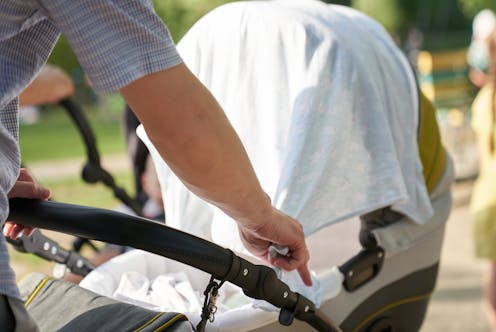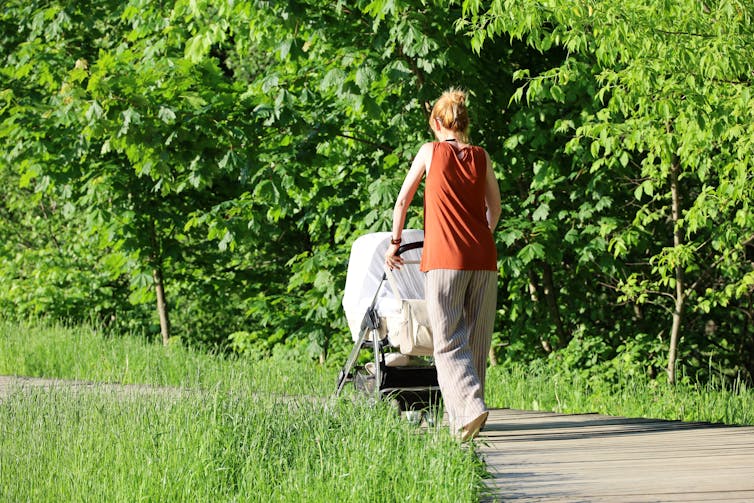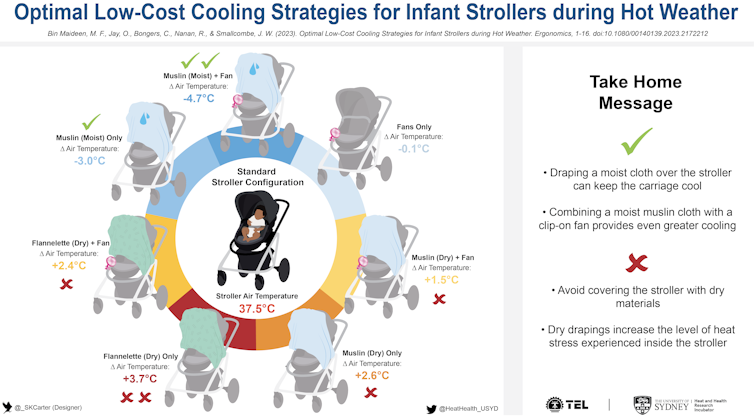
We like to think of babies as tiny versions of ourselves. But babies aren’t simply miniature adults, especially when it comes to coping in the heat. Babies are at greater risk of overheating and need different cooling strategies to those that work for adults.
Parents have long covered prams and strollers with cloth to shade the carriage from the hot sun. However, our recent study showed this can substantially increase temperatures inside the stroller.
After just 20 minutes – the time it takes to go to the shop or drop your child off at daycare – the stroller carriage was 3.7℃ hotter than outside when draped with a dry flannelette cloth and 2.6℃ when draped with dry muslin.
Attaching a battery-operated fan to the stroller wasn’t very effective either at reducing the stroller temperature, cooling the carriage by just 0.1℃ relative to outside.
But dampening the cloth can reduce the temperature in the carriage.
Read more: Top 10 tips to keep cool this summer while protecting your health and your budget
Why are babies vulnerable in the heat?
There are three main reasons why babies might struggle more in hot weather compared to adults.
First, their body shape is very different. Infants have a much greater area of skin surface available to exchange heat with the surrounding environment, compared to their body mass. This means in very hot conditions their body temperature can warm up at a much faster rate.

Second, infants can’t sweat as much as mum or dad and are therefore less able to cool down by sweat evaporation. This is the main physiological disadvantage that places them at greater risk in hot weather.
Finally – and possibly most importantly – babies are almost entirely dependent on someone else to keep them cool. Other than crying, babies can’t communicate that they are too hot. On a hot day, it is the parents who have to check for signs of distress, choose suitable clothing, and make sure shade is found during the hottest part of the day (normally noon to 3pm). Babies can’t do any of this for themselves.
Read more: Curious Kids: What happens in the body when we sweat?
So, what can be done to keep baby strollers cool?
In our same study, we also showed some strategies are really effective at cooling strollers down even on hot and sunny days.
Loosely draping a damp muslin cloth over the stroller reduced the temperature inside the stroller by 3℃.
This cooling effect was even greater when a damp cloth was combined with a clip-on fan, reducing the stroller temperature by 4.7℃ compared with outside.
This method harnesses the power of evaporation. Just like we lose body heat when sweat evaporates from our skin, the evaporation of water from the damp cloth removes heat from the air inside the stroller and lowers the temperature inside.
Using a spray bottle to regularly top-up the water in the cloth every 15-20 minutes will prevent it drying out and increase the amount of time this method will provide cool relief.

How else can I protect my baby from the heat?
Minimise the time spent outside with your infant during hot weather – get from A to B as quickly as possible.
Babies should never be left in a stationary stroller in the sun (even if covered with a damp cloth) as this reduces air movement through the stroller and increases the speed at which it heats up.
Any time infants or children are exposed to the heat, it’s important to keep them well hydrated. Drinking water or breastfeeds should be offered frequently. Infants will need more fluids during hot weather.

It’s also important to regularly check infants for signs of heat illness. The most common are:
- being overly warm to touch
- hot, red and dry skin
- irritability
- looking generally unwell and/or lethargic.
If your baby is showing signs of heat illness, find cool relief immediately and seek medical help.
Read more: Evacuating with a baby? Here's what to put in your emergency kit
James Smallcombe receives funding from National Health and Medical Research Council (NHMRC).
Ollie Jay receives funding from National Health and Medical Research Council, Wellcome Trust, NSW Health, NSW Dept of Planning, Industry and Environment, and the NSW Reconstruction Authority (formerly Resilience NSW).
Mohammad Fauzan Bin Maideen does not work for, consult, own shares in or receive funding from any company or organisation that would benefit from this article, and has disclosed no relevant affiliations beyond their academic appointment.
This article was originally published on The Conversation. Read the original article.







